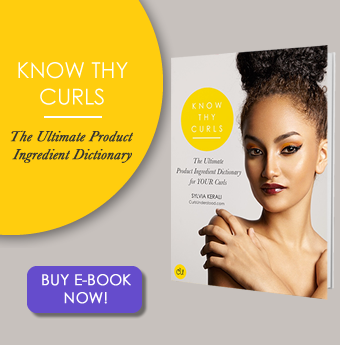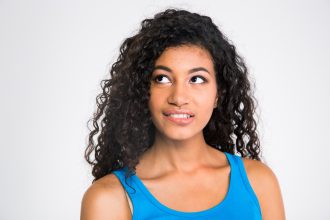Writing about my experience having natural hair in China isn’t particularly easy, not only because I have had so many ups and downs on this journey, like any other natural, but also because I know it may be difficult for some people reading this in other parts of China to find the same products and services I may speak about in my articles.
If you live in the U.S., this would be easier to grasp. For those who are abroad, I can summarize this problem by saying that the experience that one has in China is highly dependent on where you live. I live in Wuhan which is a developing city in China but I have access to many foreign and higher end Chinese brands and commodities.
In smaller cities, the degree of difficulty increases and in bigger cities they may be an even wider variety or completely different brands. This situation is further compounded by, of course, a beauty industry that caters to the biggest population on earth. The number of product lines and hair products on the shelves is dizzying in itself. Unless you don’t mind experiments and adventure upon arrival in China, that is enough to turn you off completely and resorting to finding products you are used to using.
The challenges of having natural hair in China include battling hard water in the shower, learning the Chinese characters to read labels, learning the science behind hair and modifying products to your hair’s taste.
Another problem with being a kinky girl in China is that the brands we are accustomed to or see used in most natural hair videos tutorials and articles, although possibly available via mail, do not fit nicely in the budget of a student. I refuse to have my hair take a huge slice out of my budget, so I have made my hair journey all about finding affordable Chinese brands to modify as well as using natural ingredients.
After two years on this journey, I have stumbled across, surprisingly, many Chinese products, as well as herbs and teas, that are effective for my hair type and those of my friends (both curly and kinky).
The natural hair community is small here. In fact, I’m happy that there is a semblance of a community now. In 2013, when I did my big chop, I had little to no reference about the stuff I could use in China for my hair. I’m beyond excited that I finally have an outlet to provide information that future curly haired girls can use to begin their healthy hair journey.
The challenges of having natural hair in China include battling hard water in the shower, questioning whether the few international products you choose to invest in are genuine and trusting Chinese manufacturers, who are notorious for their shortcuts, in making beauty products. It means learning the Chinese characters to read labels, learning the science behind hair and modifying products to your hair’s taste, and substituting Asian varieties of natural ingredients that you are familiar with and the constant inquiries about your hair’s status/state/style/existence (suibian xuan) by the locals.
I’ve stumbled across a very interesting and useful product which I think is befitting because it’s ability to moisturize and soften my hair during these winter months. This year, although I did do some braids in the coldest weeks of the season, I’ve made a significant effort to keep my hair out. The rationale being very simple: I can’t be bothered with braids and I love how I look with my hair.
The product I would like to discuss is a ginger “hair mask” (发莫) or what we would refer to as a ginger treatment. Ginger is very popular as a hair treatment in China and many brands carry the treatment. I’ve used Old Ginger King (姜王). I later found another version of this treatment at Mannings (a beauty supply chain ) called ginger herbal treatment for half the price and I liked it. I also use the ginger treatment from the Watsons line of hair masks but the price jumped from 9RMB to 30RMB and there was no increase to the size of the product. This article will focus on why ginger is useful in haircare as well as a comparison of both products and links to how to pages which can help you to use the ginger root at home.
Ginger root is the rhizome of the plant Zingiber officionale belonging to the family Zingiberacre which includes turmeric, cardamon and galajing . Fresh ginger root is grey on the outside and may be ivory, creamy white or pale greenish white on the inside depending on the variety.
Ginger is a very popular Eastern spice and is traditionally known for its health benefits. It fact , it is a commonplace spice in the kitchen cabinets of homes worldwide. According to the University of Maryland Medical Center Ginger contains active components such as volatile oils and compounds. The compounds which make Ginger so useful for skin and hair are :
• Magnesium ( has antibacterial properties)
• Phosphorus
• Potassium ( emollient and thickener)
• Fatty Acids
• Vitamins
It chiefly works to:
• Aid in circulation and thus hair growth by increasing blood flow to the hair follicle
• Reduce dandruff issues because of its antiseptic properties
• Contains anti-inflammatory properties reducing redness and swelling
• Prevents hair thinning due to the presence of fatty acids.
Ginger is no doubt a very useful plant and can be used in its raw form in many ways. I would feel rather hypocritical regurgitating recipes from other sources as I have never tried it in its raw form so instead I would provide some helpful links:
• How to Use Ginger For Hair Growth?
• Ginger Treatment for Hair
I would like to compare my experience with the Ginger hair mask by Old Ginger King and the Mannings Ginger Herbal Extract Hair treatment. I added Aloe Derma 99.8% aloe vera juice (This can be found at Watsons and any local Chinese beauty supply ) as well as coconut oil, jojoba oil, grape seed oil and olive oil to each of the products. For the Old Ginger King treatment , I usually mix with GENLESE One Minute Moisture Mask or Deep Restore Mask. I try to choose an odourless thick conditioner as my hair loves them and this helps to hold oils better. I kept each on for 30 minutes with a heating cap after shampooing and cowashing my hair.
Hopefully this article has been helpful and comments and questions about my hair experience in China and other products are also welcome. If you llike you can follow my hair journey on my blog for more helpful tips and pictures: Blacktoufa.tumblr.com
See how other naturally curly women care for their hair in our Being Natural In A Foreign Country series.
Photo Credit: Alexei Tsybine







Hi thank yiu for the tip, I’m moving ti to China for six months and I’d love to follow you on Instagram. The link above says the account does not existe anymore, do you have a new one active? Thanks